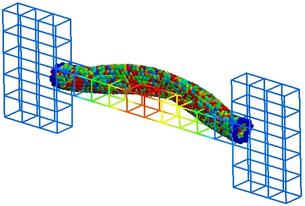\(\renewcommand{\AA}{\text{Å}}\)
fix atc command
Syntax
fix <fixID> <group> atc <type> <parameter_file>
fixID = name of fix
group = name of group fix is to be applied
type = thermal or two_temperature or hardy or field
thermal = thermal coupling with fields: temperature two_temperature = electron-phonon coupling with field: temperature and electron_temperature hardy = on-the-fly post-processing using kernel localization functions field = on-the-fly post-processing using mesh-based localization functions
parameter_file = name of the file with material parameters. Note: Neither hardy nor field requires a parameter file
Examples
fix AtC internal atc thermal Ar_thermal.dat
fix AtC internal atc two_temperature Ar_ttm.mat
fix AtC internal atc hardy
fix AtC internal atc field
Description
This fix is the beginning to creating a coupled FE/MD simulation and/or an on-the-fly estimation of continuum fields. The coupled versions of this fix do Verlet integration and the post-processing does not. After instantiating this fix, several other fix_modify commands will be needed to set up the problem (i.e., define the finite element mesh and prescribe initial and boundary conditions).

The following coupling example is typical, but non-exhaustive:
# ... commands to create and initialize the MD system
# initial fix to designate coupling type and group to apply it to
# tag group physics material_file
fix AtC internal atc thermal Ar_thermal.mat
# create a uniform 12 x 2 x 2 mesh that covers region contain the group
# nx ny nz region periodicity
fix_modify AtC mesh create 12 2 2 mdRegion f p p
# specify the control method for the type of coupling
# physics control_type
fix_modify AtC thermal control flux
# specify the initial values for the empirical field "temperature"
# field node_group value
fix_modify AtC initial temperature all 30
# create an output stream for nodal fields
# filename output_frequency
fix_modify AtC output atc_fe_output 100
run 1000
likewise for this post-processing example:
# ... commands to create and initialize the MD system
# initial fix to designate post-processing and the group to apply it to
# no material file is allowed nor required
fix AtC internal atc hardy
# for hardy fix, specific kernel function (function type and range) to # be used as a localization function
fix AtC kernel quartic_sphere 10.0
# create a uniform 1 x 1 x 1 mesh that covers region contain the group
# with periodicity this effectively creates a system average
fix_modify AtC mesh create 1 1 1 box p p p
# change from default lagrangian map to eulerian
# refreshed every 100 steps
fix_modify AtC atom_element_map eulerian 100
# start with no field defined
# add mass density, potential energy density, stress and temperature
fix_modify AtC fields add density energy stress temperature
# create an output stream for nodal fields
# filename output_frequency
fix_modify AtC output nvtFE 100 text
run 1000
the mesh’s linear interpolation functions can be used as the localization function by using the field option:
fix AtC internal atc field
fix_modify AtC mesh create 1 1 1 box p p p
...
Note coupling and post-processing can be combined in the same simulations using separate fixes.
Restart, fix_modify, output, run start/stop, minimize info
No information about this fix is written to binary restart files.
The fix_modify energy option is not supported by this fix, but this fix does add the kinetic energy imparted to atoms by the momentum coupling mode of the AtC package to the global potential energy of the system as part of thermodynamic output.
Additional fix_modify options relevant to this fix are listed below.
This fix computes a global scalar which can be accessed by various output commands. The scalar is the energy discussed in the previous paragraph. The scalar value is “extensive”.
No parameter of this fix can be used with the start/stop keywords of the run command. This fix is not invoked during energy minimization.
Restrictions
Thermal and two_temperature (coupling) types use a Verlet time-integration algorithm. The hardy type does not contain its own time-integrator and must be used with a separate fix that does contain one (e.g., nve, nvt). In addition, currently:
the coupling is restricted to thermal physics
the FE computations are done in serial on each processor.
Default
None
For detailed exposition of the theory and algorithms please see:
(Wagner) Wagner, GJ; Jones, RE; Templeton, JA; Parks, MA, “An atomistic-to-continuum coupling method for heat transfer in solids.” Special Issue of Computer Methods and Applied Mechanics (2008) 197:3351.
(Zimmerman2004) Zimmerman, JA; Webb, EB; Hoyt, JJ;. Jones, RE; Klein, PA; Bammann, DJ, “Calculation of stress in atomistic simulation.” Special Issue of Modelling and Simulation in Materials Science and Engineering (2004), 12:S319.
(Zimmerman2010) Zimmerman, JA; Jones, RE; Templeton, JA, “A material frame approach for evaluating continuum variables in atomistic simulations.” Journal of Computational Physics (2010), 229:2364.
(Templeton2010) Templeton, JA; Jones, RE; Wagner, GJ, “Application of a field-based method to spatially varying thermal transport problems in molecular dynamics.” Modelling and Simulation in Materials Science and Engineering (2010), 18:085007.
(Jones) Jones, RE; Templeton, JA; Wagner, GJ; Olmsted, D; Modine, JA, “Electron transport enhanced molecular dynamics for metals and semi-metals.” International Journal for Numerical Methods in Engineering (2010), 83:940.
(Templeton2011) Templeton, JA; Jones, RE; Lee, JW; Zimmerman, JA; Wong, BM, “A long-range electric field solver for molecular dynamics based on atomistic-to-continuum modeling.” Journal of Chemical Theory and Computation (2011), 7:1736.
(Mandadapu) Mandadapu, KK; Templeton, JA; Lee, JW, “Polarization as a field variable from molecular dynamics simulations.” Journal of Chemical Physics (2013), 139:054115.
Please refer to the standard finite element (FE) texts (e.g., T.J.R. Hughes, The Finite Element Method, Dover 2003) for the basics of FE simulations.